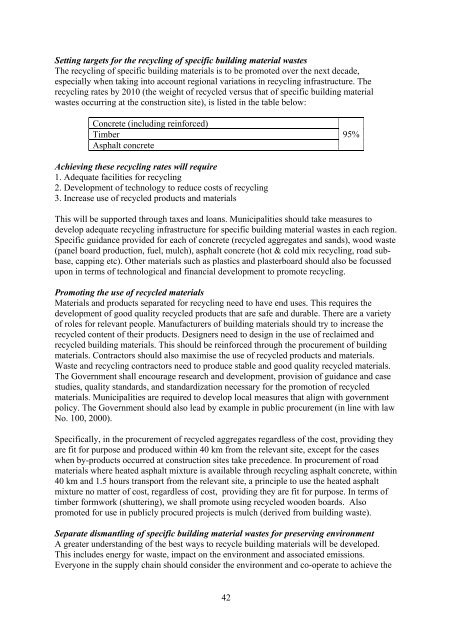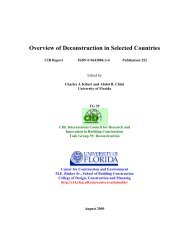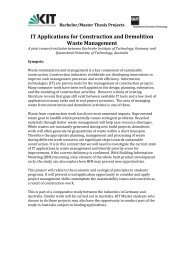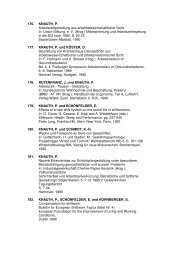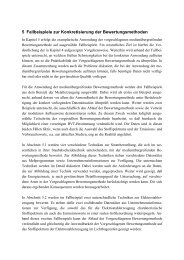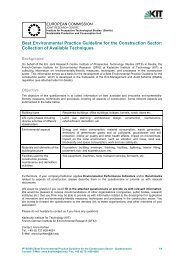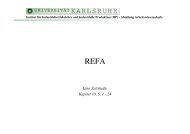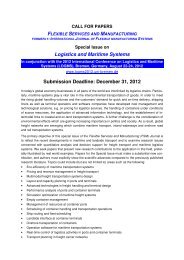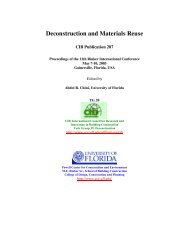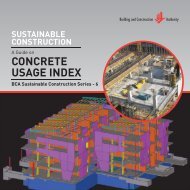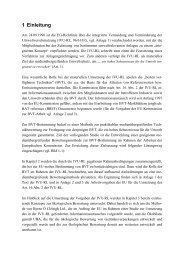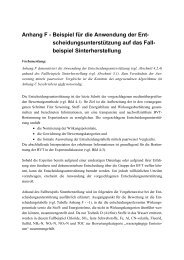Waste reduction final report -4 - Test Input
Waste reduction final report -4 - Test Input
Waste reduction final report -4 - Test Input
Create successful ePaper yourself
Turn your PDF publications into a flip-book with our unique Google optimized e-Paper software.
Setting targets for the recycling of specific building material wastes<br />
The recycling of specific building materials is to be promoted over the next decade,<br />
especially when taking into account regional variations in recycling infrastructure. The<br />
recycling rates by 2010 (the weight of recycled versus that of specific building material<br />
wastes occurring at the construction site), is listed in the table below:<br />
Concrete (including reinforced)<br />
Timber<br />
Asphalt concrete<br />
95%<br />
Achieving these recycling rates will require<br />
1. Adequate facilities for recycling<br />
2. Development of technology to reduce costs of recycling<br />
3. Increase use of recycled products and materials<br />
This will be supported through taxes and loans. Municipalities should take measures to<br />
develop adequate recycling infrastructure for specific building material wastes in each region.<br />
Specific guidance provided for each of concrete (recycled aggregates and sands), wood waste<br />
(panel board production, fuel, mulch), asphalt concrete (hot & cold mix recycling, road subbase,<br />
capping etc). Other materials such as plastics and plasterboard should also be focussed<br />
upon in terms of technological and financial development to promote recycling.<br />
Promoting the use of recycled materials<br />
Materials and products separated for recycling need to have end uses. This requires the<br />
development of good quality recycled products that are safe and durable. There are a variety<br />
of roles for relevant people. Manufacturers of building materials should try to increase the<br />
recycled content of their products. Designers need to design in the use of reclaimed and<br />
recycled building materials. This should be reinforced through the procurement of building<br />
materials. Contractors should also maximise the use of recycled products and materials.<br />
<strong>Waste</strong> and recycling contractors need to produce stable and good quality recycled materials.<br />
The Government shall encourage research and development, provision of guidance and case<br />
studies, quality standards, and standardization necessary for the promotion of recycled<br />
materials. Municipalities are required to develop local measures that align with government<br />
policy. The Government should also lead by example in public procurement (in line with law<br />
No. 100, 2000).<br />
Specifically, in the procurement of recycled aggregates regardless of the cost, providing they<br />
are fit for purpose and produced within 40 km from the relevant site, except for the cases<br />
when by-products occurred at construction sites take precedence. In procurement of road<br />
materials where heated asphalt mixture is available through recycling asphalt concrete, within<br />
40 km and 1.5 hours transport from the relevant site, a principle to use the heated asphalt<br />
mixture no matter of cost, regardless of cost, providing they are fit for purpose. In terms of<br />
timber formwork (shuttering), we shall promote using recycled wooden boards. Also<br />
promoted for use in publicly procured projects is mulch (derived from building waste).<br />
Separate dismantling of specific building material wastes for preserving environment<br />
A greater understanding of the best ways to recycle building materials will be developed.<br />
This includes energy for waste, impact on the environment and associated emissions.<br />
Everyone in the supply chain should consider the environment and co-operate to achieve the<br />
42


